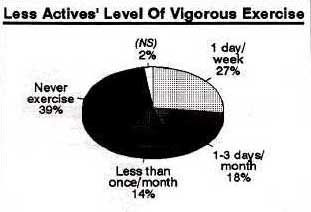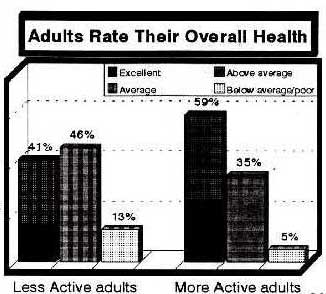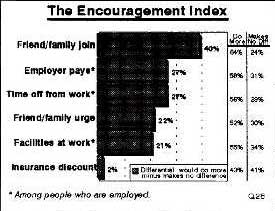|
American Attitudes Toward Physical Activity & Fitness A National Survey
President's Council on Physical Fitness & Sports in collaboration with the Sporting Goods Manufacturers Association
Survey Overview
From October 15 to 20, 1993, Peter D. Hart Research Associates conducted a national telephone survey among a representative sample of 1,018 "Less Active" American adults age 18 and over, defined as those who exercise vigorously less than twice a week. In addition, a shorter interview was conducted for comparison purposes among 1,006 "More Active" adults, who engage in vigorous exercise at least two times a week. The screening and interviewing process found that Less Actives make up 43% of the overall adult population, while More Actives represent 57% of all adults.
The purpose of the survey was to explore the attitudes of Less Active adults toward physical activity and physical fitness. In particular, the survey examines Less Actives' level of interest in increasing their physical activity, the barriers they perceive to being active, and what kinds of information and changes might lead them to expand their level of activity. The survey also recorded standard demographic information, including gender, age, income, race, and occupation.
The survey was conduced on behalf of the President's Council on Physical Fitness and Sports, in collaboration with the Sporting Goods Manufacturers Association.


Fact Sheet 1: Levels of Activity
The survey suggests that activity levels overall are not what they should be. Fully 43% of all adults qualify as "Less Actives," which means that they fail to engage in vigorous exercise even two times a week. Certain subgroups, such as women and lower-income Americans, are represented disproportionately in the Less Active group. More striking, however, is the extent to which low levels of activity can be found in all groups: young Americans as well as old, the better educated as well as the less educated. A majority of the Less Actives are under age 45, and 46% have attended college. Insufficient physical activity is not confined to pockets of our society – it is a nationwide problem.


The survey reconfirms the tremendous value of regular vigorous exercise. While only 21% of Less Active Americans report that they are in excellent or above-average physical shape, a 51% majority of More Active adults (those who exercise vigorously twice a week or more) rate their fitness at this level. Similarly, 59% of More Actives say they are in excellent or above-average health, which is well above Less Actives' 41% figure.
One more encouraging finding: most Less Actives are at least somewhat physically active. In a typical week, about four in ten Less Actives report that they spend three hours or more doing some kind of exercise, and a large majority say they engage in 30 minutes of light physical activity at least once a week. Of the 11% of Less Actives who described themselves as "not at all active," the large majority indicate that they cannot be physically active because of health or physical condition. There is thus a real base level of activity -- though it is very low -- from which to promote physical activity among the Less Actives.
Fact Sheet 2: Desire for Change

An encouraging 59% of Less Actives say they would like to be more physically active. This includes 68% of those under age 45, 71% of people holding desk jobs, and 74% of adults who are 20 pounds or more overweight. This inclination to increase activity is not limited to those who are already somewhat active, but is just as strong among those who are now very inactive. A cautionary finding, however, is that only 25% of Less Actives predict that they are certain or very likely to increase their level of activity in the next six months. Although the desire is there, most Less Actives currently do not expect to expand their activity.

Less Actives, for the most part, do not face any insurmountable obstacles to increasing their activity. A resounding 81% report that there are enough opportunities in their area to get the kind of exercise they would want. Certain groups, such as members of low-income households and African-Americans, face greater obstacles -- unsafe streets being a significant factor -- yet large majorities of these groups nonetheless feel that they can get exercise. In addition, 49% of Less Actives feel it would be easy to increase their activity level.

The "Prime Audience" for increased physical activity includes the 20% of Less Actives who say they want to be more active, would find it easy to do so, and report that they are certain or very likely to become increasingly active in the next six months. Members of this group tend to be younger than average, and are particularly likely to have exercised more regularly in the recent past. The Prime Audience is somewhat more health conscious than are other Less Actives, and 61% say they are well informed about what it takes to keep fit.
Fact Sheet 3: Barriers & Incentives to Change
Their number-one reason for not being more active, Less Actives say, is time. In an open-ended question, 43% identify lack of time -- and 15% cite family responsibilities -- as barriers to increased physical activity. The proportion who mention time is far greater than those who volunteer a comment related to health, lack of motivation, access to facilities, or any other factor.

Sixty-four percent of Less Actives agree with the statement, "I would like to exercise more, but I just can't find the time," including 75% of baby boomers, 76% of people with desk jobs, and 76% of working women.

The single greatest motivation for physical activity, the Less Active say, is concern for one's health. Health-conscious adults are far more active than are those who lack such consciousness. Nearly as important as health is the desire for greater strength and energy throughout daily life -- an "extremely strong" motivation for a majority of Less Actives. Significantly, Americans are more motivated when informed about the benefits of exercise than when told of the dangers of inactivity. Positive encouragement appears to be more effective than attempting to frighten people out of being inactive.

Fact Sheet 4: Agents of Change

The survey identifies several actors, beyond the Less Actives themselves, who have significant roles to play in promoting physical activity. The most important agents of change: friends and family. For Less Active Americans, the single most effective encouragement for exercising more often is having a friend or relative offer to exercise with them, which earns a +40% rating on the encouragement index (+69% among the Prime Audience). Verbal encouragement also produces strong motivation, especially that from a spouse. Indeed, a spouse, boyfriend, or girlfriend is the strongest possible positive influence -- well above doctors -- for such key groups as the Prime Audience and Less Actives under age 45. Perhaps this is why Less Actives who have an active spouse are themselves much more likely to be active.

Employers also have a role to play, especially in the context of the time pressures cited by many Less Actives. Majorities of those who work outside the home say the following would certainly or probably lead them to exercise more frequently: if their employer paid for the cost of a fitness center (58%); if they got time off during the workday for exercise (56%); or if they had athletic facilities at their workplace (55%). Working women and the Prime Audience rank these encouragements particularly highly.

Doctors and other health professionals can greatly increase their contribution to the nation's physical fitness. Four in ten Less Actives identify their doctor as the person who would have the greatest influence on encouraging them to be more active. Unfortunately, only 31% of Less Actives report having ever been told by a health professional to be more active -- a mere 21% in the past two years -- one of the survey's most disappointing findings. Among Less Actives whose doctor has encouraged an increase in activity, 71% say they would like to be more physically active (which is 17% higher than among those who have not been so encouraged).
Peter D. Hart Research Associates
|

